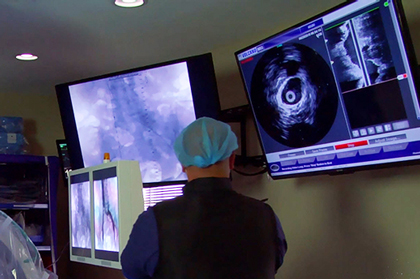Technique advancements in left main coronary artery angioplasty have turned this procedure into a reasonable alternative to surgery, particularly in patients with a low or intermediate Syntax score and, obviously, those in whom surgery was contraindicated.

Results can be credited to a refinement in technique, better drug-eluting stents, better patient selection, and frequent use of coronary intravascular ultrasound (IVUS) to guide and monitor the procedure.
IVUS has been strongly associated with the best results, both in randomized trials and in registries, and it currently holds a class IIa recommendation in guidelines. However, despite all of that, there is a wide variation in the use of IVUS, both in terms of region and operator opinion.
Many experienced operators may feel that, with an angiography, their eyes are just as good as an IVUS, but that is false and it goes against plenty of evidence. Other reasons behind such dispersion in use may be of economic nature. There are regions where this practice is not covered by health insurance, while it is covered in full in others. For example, in Japan, this practice is 100% covered, which easily explains why IVUS is used in over 85% of all angioplasty procedures conducted there.
Read also: Aortic Valvuloplasty as a Bridge to TAVR: Are We Wasting Our Time?
This study, recently published in JACC Cardiovascular Interventions, analyzed the trend in the use of IVUS and the outcomes of unprotected left main coronary artery angioplasty in England.
With over 11,000 patients included, this work represents the largest registry in the world accounting for the use of IVUS in this setting.
IVUS use increased from 30.2% in 2007 to 50.2% in 2014. After adjusting for multiple variables, the use of IVUS was associated with a reduction in major cardiovascular events at 30 days (46%) and one year (34%).
If we analyze mortality alone, there is a 4% reduction at 30 days and a 10% reduction at 12 months, approximately.
This trend was consistent with an increase in the use of IVUS, which means that the influence of other variables (technique, drugs, etc.) on the outcomes is highly unlikely.
IVUS is definitely a necessity in left main coronary artery angioplasty, but it is also a luxury. In England, in the best of cases, only half the patients had an IVUS during their left main coronary artery angioplasty.
Original Title: Intravascular Imaging and 12-Month Mortality After Unprotected Left Main Stem PCI. An Analysis From the British Cardiovascular Intervention Society Database.
Reference: Tim Kinnaird et al. J Am Coll Cardiol Intv 2020;13:346–57.
Subscribe to our weekly newsletter
Get the latest scientific articles on interventional cardiology





